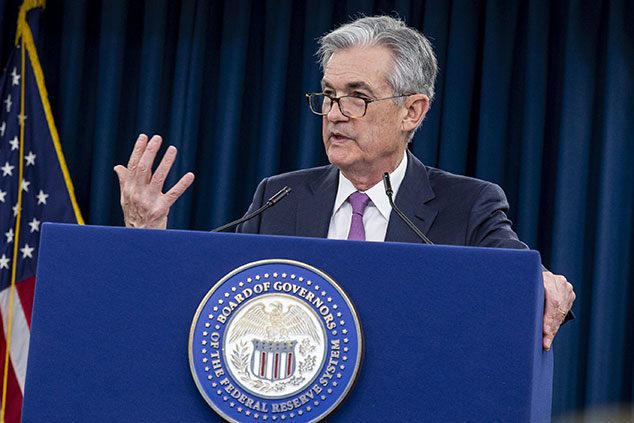
This article is taken from our FREE daily investment email Money Morning.
Every day, MoneyWeek’s executive editor John Stepek and guest contributors explain how current economic and political developments are affecting the markets and your wealth, and give you pointers on how you can profit.
The Federal Reserve, the US central bank, kept interest rates on hold at the 2.25% to 2.5% level yesterday.
That surprised no one. But the decision still ended up knocking the market off its latest high.
What gives?
The Federal Reserve plays it tough
I said earlier this week that you shouldn’t be surprised if the Federal Reserve “sounds even more nervous at its next meeting than it did at the last.”
It seems I underestimated Jerome Powell and colleagues. And that’s why US stock markets had an unpleasant session yesterday afternoon.
It’s not what Powell said. As John Authers notes on Bloomberg: “Powell basically said that the FOMC [Federal Open Market Committee] was comfortable with its current stance and was not biased in either way.” It’s what he didn’t say.
On the one hand, he didn’t say: “Wow US growth is strong, we’d better start raising rates again.” That would have sent stocks plunging rather than gently declining.
But markets had been hoping and even expecting that Powell would conform to the post-Greenspan norm. That is, they threaten to throw a wobbly, and the Fed chair of the day immediately retreats and tenderly administers some laudanum.
But Powell didn’t do that. While he didn’t show any sign of wanting to raise rates, nor did he say anything to indicate: “OK, markets, we hear you – we know you’re freaked out and we’ll be cutting rates as soon as we get an excuse to do so.” There was no sign of quantitative tightening being ended earlier than planned either.
In fact, Powell even suggested that temporary factors might be holding down inflation. That’s not very Greenspan of him – he should have leapt on March’s low inflation figure as a good excuse to nod towards a pending rate cut.
So markets had a wee swoon, and no one was there to catch them.
Why good economic news is probably good for markets too right now
What does this all mean?
Here’s the upshot: what the market really wants is for monetary policy to be a bit looser than necessary. That’s a little bit subjective – I’m not going to give you an exact interest rate here – but the broad strokes are simple.
If economic growth and inflation are accelerating, the market wants the Fed to lag behind. It can raise rates, but growth has to be coming in faster. If growth is decelerating, then the market wants the Fed to be ahead of the game – either cutting rates or signalling that it is ready to do so.
This is why markets often have an ambivalent attitude towards economic data. Sometimes “good” economic data is “bad” for markets, because it signals higher interest rates. And sometimes “bad” data is “good”, because investors then expect to see looser monetary policy.
So where are we right now? Well, monetary policy can get “easier” from here in two different ways. One, the Fed can cut rates or halt quantitative tightening early. Two, the economy can grow faster, and inflation expectations can rise, while the Fed stays put.
For now, investors are still convinced that an economic collapse is imminent. But it’s also clear to them that the Fed is not convinced. They think the Fed is wrong. So for markets to turn happy again, they have to start believing that the Fed is right.
As a result of this, any bad economic news right now will just be viewed as “bad”, for markets too, because investors don’t think the Fed is alert to the problems they think they see out there.
So for markets to go up from here, we need to see more “good” economic news. We need to see inflation picking up again. We need to see growth surprising on the upside in a consistent and relatively frequent manner.
Will that happen? The next big economic reading is the monthly jobs report on Friday. This data is extremely volatile, but that doesn’t stop everyone from reacting to it.
This week, I would expect markets to be reassured by a strong reading, preferably with some solid wage inflation (the latest private payrolls report, which came out yesterday, was very strong, but that doesn’t always reflect on the official figures).
If it comes in weak, the idea that the Fed is “behind the curve” will remain in play. At that point, there’ll be nothing for the market to do but to stage another near-bear market in the hope that it makes the Fed change its mind.
I have to say, I’m still not convinced by the imminent recession mob. I’m still in the “melt-up” then “meltdown” camp. How long might that take? We have a few candidates for “top of the market” IPO coming up fast (this is a warning sign that I go into in more detail in my book, The Sceptical Investor – you can buy that here, if you haven’t already).
There’s the Uber IPO, which looks as though it’ll prove popular. But even better is the idea that WeWork – the office sub-letting company that pretends it’s a tech start-up – is set to go public. We’ll look at that another day. But one thing’s for sure – for the most-hated bull market ever, there sure is a lot of irrational exuberance out there.